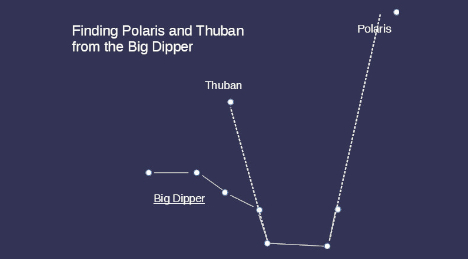Thuban
Psalm 19:1-3
“The heavens declare the glory of God; and the firmament sheweth his handywork. Day unto day uttereth speech, and night unto night sheweth knowledge. There is no speech nor language, where their voice is not heard.”

Those of you who grew up in the Scouts or a similar uniformed children’s club were probably taught to find North by the stars. This relies on first finding the Big Dipper and then tracing an imaginary line in the sky through the outer two stars of the “dip”. This line leads to the star Polaris, which is almost exactly above the Earth’s North Pole. So, if you are facing Polaris, you are facing North.
The Earth’s axis is declined at an angle of just over 23° to a line perpendicular to the plane of the Earth’s orbit. However, the axial line has not always pointed towards Polaris. During the time when the pyramids were built in Egypt, a different star was above the North Pole. The pyramids were probably built early in the days of the Egyptian civilization, which must have been fairly shortly after the scattering from Babel.
At that time, a faint star called Thuban would have been the Pole Star. Thuban, in the constellation of Draco the Dragon, is found by tracing an imaginary line from the inner stars of the Big Dipper. Thuban is, therefore, one of the most anciently studied stars; yet, a recent study has found out something new. Thuban has a fainter companion star, and this star regularly eclipses the main star, causing a change in Thuban’s brightness. This proves to me that there is always something new to learn about God’s universe. Truly the heavens declare His glory!
Prayer: As we look at Your heavens, Lord, we stand in awe at all that You have made. The heavens declare Your glory. Amen.
Author: Paul F. Taylor
Ref: NASA/Goddard Space Flight Center. “Surprise! TESS shows ancient north star undergoes eclipses.” ScienceDaily, 7 January 2020. <www.sciencedaily.com/releases/2020/01/200107104938.htm>. Image: Created by author.
© 2021 Creation Moments. All rights reserved.